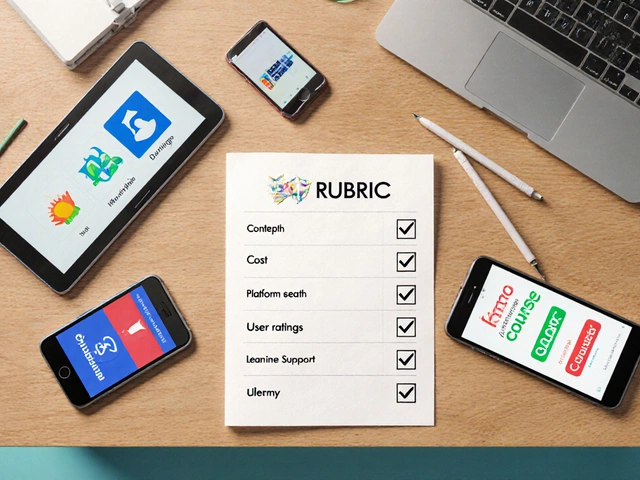Sep
16

- by Dhruv Ainsley
- 0 Comments
You want fluency fast, not five different apps and a pile of half-finished textbooks. Here’s the deal: you can reach solid conversational fluency (think: 15-minute chats without freezing, understanding most everyday English with subtitles) in 60-90 days if you set up the right system and stick to it daily. Not native-like, not perfect, but confident, fast, and useful. I live in Melbourne and I see it all the time-migrants and students who get farther in three focused months than in two distracted years.
TL;DR: The Fast Track That Actually Works
- Definition of “fast fluency”: Hold 15-20 minute conversations on everyday topics with minimal pauses, understand 80%+ of shows with subtitles, write clear messages at work or school.
- Timeframe: 60-90 days if you can give 90-150 minutes daily. If you’re starting from zero, add 2-3 weeks to learn sounds and the alphabet well.
- The engine: 50% listening/reading you can mostly understand (comprehensible input), 30% 1‑on‑1 speaking with correction, 20% phrase-based review using spaced repetition.
- Vocabulary strategy: 2,000-3,000 high-frequency words and chunks first (covers most daily speech; Paul Nation, Oxford 3000/5000). Learn phrases, not single words.
- Pronunciation is not a final touch. Train it from day one (shadowing, minimal pairs, sentence stress). Clear beats perfect.
- Feedback cycle: Record yourself weekly, get tutor notes, fix only the few errors that block understanding or repeat a lot.
- Tools: A tutor or exchange partner, an SRS app (Anki), a pronunciation app or site, YouGlish, Netflix/Youtube with subtitles, a note app. Keep it lean.
Core promise: The fastest way to be fluent in English is daily high-quality speaking with correction, fueled by understandable input and locked in with spaced repetition-done consistently for 8-12 weeks.

The 90‑Day Plan: Daily Steps, Real Examples, Checklists
I’ll map a 30/60/90‑day arc I’ve used with busy adults in Melbourne. If you’re a student or a parent, tweak the minutes but keep the ratios.
Daily schedule (90-150 minutes):
- Pronunciation + shadowing (20-30 min): Warm up your mouth. Shadow a short clip at 0.75-1.0x speed. Focus on stress and linking, not every tiny sound.
- Input you mostly understand (40-60 min): Watch or read topics you like (news explainers, travel, work talk). Use subtitles/captions you can follow. Pause, rewind, echo sentences.
- Speaking with feedback (20-40 min): One‑on‑one tutor or language partner. Use targeted prompts. Ask for correction on 1-3 repeat errors, not everything.
- Phrase review (10-20 min): SRS flashcards with full phrases you actually said or want to say. Keep it tight: 20-40 reviews/day.
Weekly rhythm:
- Mon-Fri: Follow the daily schedule.
- Sat: 30-60 minutes to record a 2-3 minute monologue on your week; compare with last week; note one pronunciation and one grammar fix.
- Sun: Light input only (podcast while cooking, walk with headphones) and reset your cards and materials.
What to study first (the 80/20 set):
- High-frequency verbs: be, have, do, get, go, make, take, want, need, like, know, think, say, tell, can, should, would.
- Daily chunks: “I’m looking for…”, “Could you help me with…?”, “The reason is…”, “As far as I know…”, “What I mean is…”.
- Functional frames: asking for clarification, opinions, agreeing/disagreeing, giving examples, summarizing.
- Topics you’ll actually use: work updates, study plans, small talk, weekend plans, food, travel, health appointments, customer service calls.
Why this works (quick science):
- Comprehensible input (Krashen) feeds grammar and vocabulary naturally.
- Spaced repetition (Ebbinghaus) beats cramming; short, daily reviews stick.
- High-frequency vocabulary (Paul Nation) unlocks most real-life texts and talks.
- Pronunciation training with varied examples (high-variability phonetic training) helps adults form new sound categories.
30-60-90 day milestones:
- Day 1-30: Learn core sounds, master 300-500 high-frequency phrases, handle scripted small talk and basic work/study updates. Aim: 1-2 minute answers without freezing.
- Day 31-60: Expand to 1,500+ words you can actually use; handle phone calls and short stories. Aim: 10-12 minute conversations at 100-120 words per minute.
- Day 61-90: Tackle faster speech, slang, and complex opinions. Aim: 15-20 minute conversations with minimal hesitation; understand most TV with subtitles.
Conversation scripts you’ll recycle a lot:
- Self-intro: “Hi, I’m [name]. I’m based in [city]. I work/study in [field]. Recently I’ve been [project].”
- Weekend: “On Saturday I [activity]. The best part was [detail] because [reason].”
- Work update: “Yesterday I finished [task]. Today I’m focusing on [task]. I might need help with [blocker].”
- Opinion: “From my point of view, [position]. The main reason is [reason]. For example, [specific example].”
- Story: “So this morning, I was on the tram in Melbourne when [event]. First…, then…, finally….”
Write these scripts, record them, refine them with a tutor, then freestyle. Building from chunks is faster than building from grammar rules.
Fluency drills that punch above their weight:
- 3-2-1: Speak on a topic for 3 minutes, then the same topic for 2, then 1. You’ll cut filler and boost speed.
- Retell a clip: Watch a 60-90 second video. Pause. Retell the story in your own words. Check what you missed.
- Phrase substitution: “I’m looking for X” → “I’m trying to find…”, “I’d like to get…”, “I need to pick up…”.
- Minimal pairs for clear sounds: ship/sheep, live/leave, walk/work. Use a pronunciation app or YouGlish examples.
Pronunciation quick wins (don’t skip):
- Stress the right syllable: PHOtograph vs. phoTOGraphy.
- Use the schwa /ə/: about, support, comfortable. It makes your rhythm natural.
- Linking: “want to” → “wanna”, “I have to” → “I hafta”. You don’t need to speak like this, but you must hear it.
- Sentence stress: Emphasize content words (nouns/verbs/adjectives), reduce function words. Record yourself to check rhythm.
Tool stack (lean and effective):
- SRS: Anki (free). Use sentence cards with audio; 20-40 reviews/day.
- Pronunciation: ELSA Speak or Speechling for feedback; YouGlish for real examples.
- Tutors/partners: italki or Preply (paid); Tandem/HelloTalk (free); local meetups if you’re in a city like Melbourne.
- Input: Netflix/YouTube + subtitles; BBC Learning English; podcasts with transcripts (ESLPod, VOA Learning English, All Ears English).
- Writing support: Grammarly for quick checks, but don’t let it rewrite everything-learn from the fixes.
What exactly to add to Anki (or any SRS):
- Phrases you personally said in a lesson that needed correction. Example: “I didn’t went” → “I didn’t go.” Save both for awareness.
- High-utility chunks: “As far as I know…”, “It depends on…”, “I’ve been meaning to…”.
- Pronunciation traps with IPA notes if helpful. Keep cards short and speak them aloud.
Checklist to avoid common traps:
- One tutor you meet 3x/week beats five tutors you meet once.
- Pick one main show/podcast and go deep. Don’t hop every day.
- Every new word must live in a phrase and in your mouth (say it!).
- Correction limit: 3 issues per session. More kills flow.
- Record a weekly 2-3 minute monologue. If you’re not recording, you’re guessing.
Metrics that prove you’re improving:
- Speaking speed: 100-140 words/min in a clear monologue. Time and count words weekly.
- Listening comprehension: From a transcripted clip, note % understood before reading the text. Aim for 70% → 85% in 8 weeks.
- Active vocabulary: 1,200+ phrases you can produce. Track “mature” SRS cards and what you actually use in lessons.
- Error rate: One repeated grammar error you’re fixing each week. Keep a tiny “hit list.”
Sample 7‑day micro-plan (repeat and rotate topics):
- Mon: Small talk + weekend. Drill linking and sentence stress.
- Tue: Work/study update. Focus on past tense and “I’ve been…” structures.
- Wed: Opinion + reasons. Practice “In my view… because… for example…”.
- Thu: Story from your life. Use 3-2-1 drill.
- Fri: Listening day with retell. Pick one 3-5 minute video.
- Sat: Record your weekly monologue, get feedback, add 10 new phrases to SRS.
- Sun: Light input while cooking or walking. Reset materials.
No native speakers around? Use voice notes on Tandem/HelloTalk, join Discord speaking rooms, or grab a low-cost group class. You can also practice with AI voice chat to build reps, then validate with a human tutor twice a week.
Short on time? Try the 45‑minute version:
- 15 min shadowing + minimal pairs.
- 15 min input you can mostly follow (subtitled video).
- 15 min speaking (alternate days: tutor / voice notes / monologue recording).
Pitfalls to avoid:
- Collecting apps instead of building habits.
- Memorizing isolated word lists with no speaking practice.
- Waiting to speak “after I finish the book.” Speak from day one.
- Over-correction in lessons. Too much feedback kills fluency.

Sticking Points, Mini‑FAQ, and Next Steps
FAQ
- How fast can I get fluent if I’m a true beginner?
If you start from zero, spend 2-3 weeks on sounds, the alphabet, and 300 core phrases. Then the 90‑day plan applies. Expect 12-16 weeks to reach strong conversational fluency. - Do I need grammar study?
Yes, but light and targeted. Learn one pattern, then speak it 20 times in real sentences. Prioritize: past simple, present perfect for life experience, future with “going to/will,” modals (can/should/would), and conditionals for opinions. - How do I reduce my accent?
Aim for clarity, not a different identity. Train stress/rhythm, common vowel contrasts, and linking. Use high-variability listening (many voices). Record and compare weekly. - Can I think in English?
Yes, by speaking in chunks. Ban translation during drills. Use “talk to yourself” sessions while cooking or walking. Describe what you’re doing in English for two minutes. - I understand a lot but can’t speak. Why?
You lack output reps and retrieval speed. Do the 3-2-1 drill daily and book three speaking sessions per week. Move phrases from “I recognize this” to “I can say this fast.” - I’m shy in groups. Any workaround?
Start with 1‑on‑1. Use audio messages, then video, then group. Practice “bridge phrases” like “Give me a second to think…” to buy time. - How do I prepare for IELTS/TOEFL while chasing fluency?
Keep the core plan but add 30 minutes, 4 days a week, for test tasks. Learn the band descriptors, practice under time, and get targeted feedback. Fluency plus format wins. - What if I don’t have money for a tutor?
Language exchange (Tandem/HelloTalk), Discord rooms, local libraries, and community groups are free. Pair that with consistent self-recording and feedback from peers. - How many words do I need?
About 2,000-3,000 high-frequency words used in phrases cover most daily conversations. Add domain words you need for work or study as you go. - What does a good correction look like?
Short and focused: “I didn’t went → I didn’t go” + one sentence example + you repeat it three times and use it later in the chat.
Decision guide: if you have 90 minutes/day, where to put it?
- Goal: Speak at work in 2 months → 40% speaking with correction, 40% work-related input, 20% review.
- Goal: Understand TV fast → 50% listening with subtitles + retells, 30% shadowing, 20% speaking.
- Goal: Pass IELTS Speaking 6.5+ → 40% task practice with feedback, 30% input, 20% shadowing, 10% review.
Exact prompts for tutors/partners (copy/paste):
- “Please correct only my repeated mistakes and anything that blocks understanding. At the end, give me 3 key fixes with examples.”
- “Let’s do 3-2-1 on this topic: my week, my job, a news story.”
- “Ask me 5 follow-up questions after every answer, don’t let me stop at one sentence.”
- “At minute 20, test me on today’s phrases.”
Templates you can use today:
- Feedback log: Today’s date → 3 phrases I want to use → 3 errors to fix → 1 pronunciation note → Next session plan.
- Monologue script: Hook → 3 points → mini-story → takeaway. Keep it to 120-140 words/min.
- SRS rule: Add 10 new phrases/day, review 20-40/day, delete cards you never use.
When you hit a plateau, do this:
- Raise input difficulty by 10% (faster talkers, fewer subtitles, new topics).
- Switch to a new tutor style for two weeks (more interruptions and drills).
- Start a 30‑day challenge: 2‑minute daily vlog. Post privately if you prefer.
If you’re in a mixed-language city (like Melbourne): Use the commute for listening. Say your coffee order and one follow-up question. Join one meetup per month. Real-life reps compound fast.
Quick safety check for burnout:
- Are you enjoying at least half your input? If not, change the show/topic.
- Are you getting wins weekly (a clearer recording, fewer pauses)? Write them down.
- Is your sleep okay? Tired brains don’t store language well.
Resources by level:
- Beginner to A2: ESLPod, VOA Learning English, Easy English (YouTube), graded readers, Pimsleur (short speaking prompts).
- B1-B2: RealLife English Podcast, TED-Ed with transcripts, Netflix dramas with clear speech, short news explainers.
- B2+: Native podcasts you like, unscripted interviews, debates, audiobooks at 1.0-1.25x.
Final 7 rules to keep you fast and honest:
- Speak from day one.
- Learn phrases, not words.
- Correct a little, practice a lot.
- Repeat fewer materials more deeply.
- Track one number weekly (speed or % understood).
- Make it social at least twice a week.
- Protect your 90 minutes like a meeting with your future self.
If you follow this, 8-12 weeks from now you’ll sound more natural, you’ll think in English more often, and you’ll stop dodging conversations. Fluency isn’t magic. It’s reps, feedback, and momentum-stacked daily.





